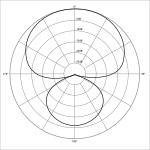Pressure gradient microphone
A pressure gradient microphone (better: microphone with pressure gradient characteristics) describes a microphone design in terms of its acoustic functionality. In contrast to a pressure microphone, the microphone capsule is open at the back, so the membrane is accessible to sound from all sides. Depending on the variant, the simple pressure gradient microphone has directional characteristics between cardioid and figure eight.
With the pressure gradient microphone, the electrical signals generated are proportional to the pressure gradient . In teaching, all microphones apart from the pure pressure receivers (omnidirectional characteristics) are called pressure gradient receivers . That is why the wide kidney (between the ball and the kidney) is also a pressure gradient receiver. In terms of their effectiveness, these are all directional microphones .
Principle and characteristics
The characteristic of a pressure gradient microphone is that the sound-receiving membrane is exposed to the sound field from both sides. Since the sound also reaches the rear of the membrane, it does not follow the absolute sound pressure , as is the case with the pressure receiver, but the pressure gradient , i.e. the pressure difference resulting from the acoustic detour between the front and rear.
This difference arises because the sound has to travel around the membrane in order to have an effect on its rear side. The time Δt required for this results in a “pressure difference” (a pressure gradient).
For a given Δt , the faster the change in sound pressure, the higher the pressure gradient. The resulting pressure gradient Δp decreases accordingly towards lower frequencies . See: acoustic short circuit .
If a signal hits the diaphragm exactly from the side (90 °), there is no pressure difference and therefore no diaphragm movement. It follows from this that the polarity of the resulting microphone signal is rotated (voltage-inverted) when the membrane is exposed to sound
Acoustic characteristics of the pressure gradient microphone
Pressure gradient microphones are not suitable for recording the lowest frequencies. The lowest frequency that can be represented depends on the detour Δt that the sound has to travel to compensate for the pressure gradient on the back of the membrane.
Another effect is the proximity effect (see graphic): Wavefronts that hit the membrane are strongly curved near the sound source because they spread out spherically. This increases the acoustic detour Δt , and thus also the gradient and thus the sensitivity to low frequencies. If the distance between the microphone and the sound source is less than about half a meter, pressure gradient receivers therefore react with a clear increase in the bass. Conversely, pressure gradient microphones sound quite poor in depth at a greater distance from the sound source.
Directional characteristics
The directivity is described basic construction, the one night. The symmetry of the microphone capsule and its suspension in the microphone also allow other directional characteristics to be achieved. The manufacturers work with acoustic term elements (acoustic "detours" between the front and rear of the membrane) and with systems that are acoustically half-closed towards the rear. This results in directional characteristics that lie between omnidirectional and figure eight, such as the “wide cardioid”, the cardioid, the supercardioid and the hypercardioid. Sometimes condenser microphones in pressure gradient design have a switchable directional characteristic. Such large diaphragm systems are built as double gradient microphones (also: double gradient receivers) that work “back to back” with two combined membranes. The directional characteristics result from the combination of different membrane charges and signal polarities of the two membranes

|

|

|
| eight
Figure Eight |
Hypercardioid
Hypercardioid |
Supercardioid
Supercardioid |
|---|

|

|

|
| kidney
Cardioid |
Broad kidney
Subcardioid |
Bullet
omnidirectional |
|---|
All directional characteristics except the sphere ( pressure microphone ) can only be achieved with pressure gradient microphones. Most of the commercially available microphones have the acoustic design of a pressure gradient microphone. With a microphone that cannot be switched, only the directional characteristic of a sphere indicates the acoustic design of a pressure microphone.
See also
literature
- Michael Dickreiter , Volker Dittel, Wolfgang Hoeg, Martin Wöhr (eds.): Manual of the recording studio technology . 8th, revised and expanded edition, 2 volumes. Walter de Gruyter, Berlin / Boston 2014, ISBN 978-3-11-028978-7 or e- ISBN 978-3-11-031650-6
Web links
- Pressure gradient and sound velocity are not the same. (PDF; 144 kB)
- Pressure gradients - correlation of the microphone directional characteristics. (PDF; 77 kB)
- Pressure gradients - all microphone polar patterns and other parameters. (PDF; 314 kB)
- The difference between hypercardioid and supercardioid. (PDF; 118 kB)
Individual evidence
- ↑ Thomas Görne: Microphones in theory and practice . 2nd Edition. 1996, p. 41 ff.
- ^ Michael Dickreiter: Handbook of the recording studio technology . 6th edition. 1997, Volume 1, p. 164
- ^ Michael Dickreiter: Handbook of the recording studio technology . 6th edition. 1997, Volume 1, p. 151
- ↑ Approaches to explaining the proximity effect (PDF) sengpielaudio.com
- ^ Michael Dickreiter: Handbook of the recording studio technology . 6th edition. 1997, Volume 1, p. 182
- ↑ Thomas Görne: Microphones in theory and practice . 2nd Edition. 1996, p. 87


